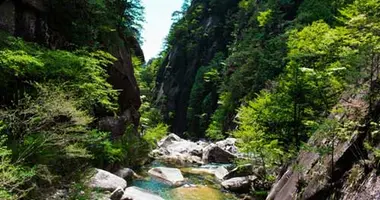Visit Tokyo in the footsteps of Hiroshige
On the roads of Edo
Hiroshige, as an Edokko (child of Edo), loved his hometown. His series of prints, One hundred famous views of Edo (1856-1859), is a tribute to the beauty, history and personality of the Japanese capital. Discover the famous views still present in Tokyo!
Famous views
The e-meisho, ukiyo-e prints of famous sites by Hiroshige and Hokusai were part of a long tradition of popular travel literature in Edo from the late eighteenth century, the meisho-zue, "illustrated books of famous sights". These illustrated collections were used as real travel guides by residents and people passing through the capital. Whether they represent famous views (meisho), famous shops (meiten) or famous products (meibutsu), the prints, partly inspired by these books, were highly appreciated by the new bourgeois class of the Edo period, eager for entertainment and travel.
Read : Ukiyo-e, the art of Japanese printmaking
A child of Edo
Originally from the capital, Utagawa Hiroshige (1797-1858) initially followed in his father's footsteps by taking over the hereditary position of firefighter. In 1809 he simultaneously began training as an artist in the workshop of Utagawa Toyohiro (1773-1828). At first he tried a multitude of genres including bijin-ga (images of beautiful women), musha-e (samurai prints or military subjects) and yakusha-e (actors' illustrations), he found eventual success thanks to his landscapes. He made many series of prints of famous views of Japan from the 1830s onwards. His series The Fifty-three Stations of the Tokaido (1833-1834) brought him fame. Next was the Sixty-nine stations of the Kisokaido (1839), the Famous views of the Sixty-odd Provinces (1853-1856) and the One Hundred Famous Views of Edo (Meisho Edo Hyakkei) between 1856-1858; a set of 119 prints showcasing the glory of his hometown, Edo.
Read also : The Ota Museum in Tokyo
The unavoidable
Built in 1603, Nihonbashi Bridge, literally the bridge of Japan, is the first print of the Hiroshige series. The starting point of the Tokaido and Kisokaido (or Nakasendo) roads in the heart of Edo, it was one of the hotspots of the capital, in the immediate vicinity of many shops and full of merchants, official processions or simple inhabitants. Originally made of wood, the bridge was rebuilt in stone and steel in 1911, and then partially hidden by an impressive expressway in the 1960s.
To discover: Our 'Tokaido Route' small group tour
You can, however, admire a replica of the original bridge at the Edo-Tokyo Museum. Another must-see in the capital that you can always visit in Tokyo is Senso-ji Temple in Asakusa. In the 99th print in his series, Hiroshige adopts an original composition; placing the big red lantern of the Kaminari-mon (Thunder Gate) in the foreground. The main building of the temple is completely concealed by the Hozomon door (door of the treasure room) and the pagoda in the background.
Step by step
Hiroshige doesn't only portray the most famous places in Edo. He takes us to more discreet places in the capital; the opportunity to experience Hiroshige's Edo. He depicts Atago Shrine, founded in 1603 and peaking at 26 meters above sea level in his 21st printm. Located on top of a hill, it is a place of refuge for the population in case of fire or other disaster.
The print representing the Kameido Tenjin and its bridge-drum is one of the best known of the series, and was particularly appreciated by the impressionist artists in Europe, however this temple is forgotten by many tourists. Don't hesitate to visit between late April and early May to admire the flowering wisteria.
This series, produced from 1856, was his ultimate success; Hiroshige died during a cholera epidemic in 1858. He left a last poem on his tomb, which he dedicated to his beloved city:
"I leave my brush in the EastAnd set forth on my journey.I shall see the famous places in the Western Land."















































